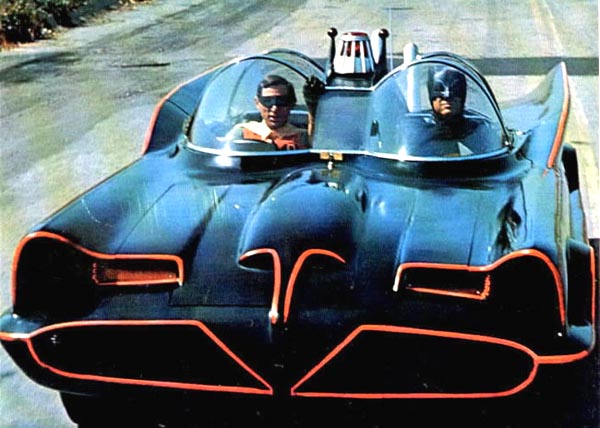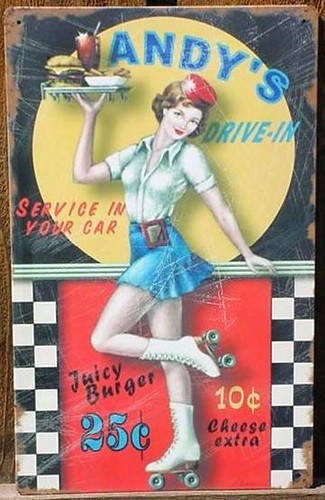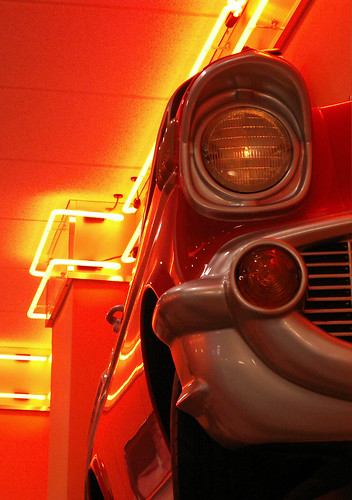THE BATMOBILE!
Pow! Bang! Zoom!
By: Mike Marino

The Sixties were more than Flower Power and Haight Ashbury with the strains of the Grateful Dead drifting across the land. It was more than Peace and Love, it was also Pow! Bang! Zoom! when it came to high camp and pop culture. Hallucinagenic waterpipes were giving way to superhero tailpipes, and no where were the tailpipes higher than on a peculiar torqued up, turbine powered asphalt eating beast worthy of a Caped Crusaders mighty crime fightin' vehicle. Superman may have had superpowers, but damn, he didn't have a car. Batman did and The Batmobile pulled off the starting line of the dragstrip of pop culture and chrome! Only Batman and the Boy Wonder could pull off a leather and leotard 1920's Berlin cabaret look and actually make it look manly, well sort of, but at least the car had balls! The crime fighting duo took on a cast of comic book characters straight out of a nightmare. The Joker. The Riddler. Mr. Freeze. Devious devices designed to destroy all of mankind were thwarted by the two crime fighting tight fisted men in tights. On the other hand, dress Julie Newmar up in ass-hugging Catwoman leather pants, high black boots and a whip, and you have a dream come true.. Colorful crime fighters, indeed, but the real star was not Bruce Wayne, not Alfred, and no, not Dick Grayson. It was no less than a turbo charged jet black one vehicle Panzer division with batwings known simply as The Batmobile.
The Batmobile had class and brass. It was starship power with the sleek svelt look of that sexy classy chassis..pulsating and rippling, black sabbath metal and fiberglass, whirring turbines and enough gadgets and gizmo's to chock James Bond on a Martini olive of inovation. "Holy Headers Batman, this beast kicks asphalt!" Bruce Wayne nods, "Yes, it does Boy Wonder. May I call you Boy Wonder? This magnificent machine is an asphalt eating crime fighter, way beyond it's time. Let Superman have his yellow sun induced gravity fighting super powers, me, I've got horsepower to the max, Baby."
George Barris!

The roots of the legendary Batmobile go deep and are lodged in the year of our Ford, 1955. The designers at Ford-Mercury were hard at work developing a concept car of the future, as were all auto manufacturers in an assemblyline space race of their own. The styling alone was spaceage with a touch of alien inspired design, and you'd swear Michael Rennie was ready to make the earth stand still with his mighty robot Gort. The car was called the "Futura" and designed by the Versacci of auto design of the day, Ghia of Italy. Fast forward to the Sixties.
1965. Hollywood. Batman is on the drawing board and ready to leap to life from the pages of a comic book to the small screen of the vaste land of television. The producers scratched their heads. "We need a car. Not just any car either. We need, a car with chutzpah, and chutzpah to spare, and even more chutzpah after that." The design challenge was finally dropped like an excited salmon in the lap of the King of the Kustomizers, George Barris, and he had three weeks to pull it off and pull it off he did, and in the process gave birth to a pop culture icon that still revs and races through the dark, wet Tim Burton streets of celluloid Gotham City.
Goerge Barris was born in Chicago, Illinois in the 1920'a and had eventually moved to California where his hobby of building model aircraft in his teen years eventually brought him to the landing strip of automotive pop culture. After George and his brother Sam restored an old 1925 battleship Buick from heap to hip there was no stopping the maestro's of machine and after WWII the brothers began customizing cars for other afficianado's of automobilia. As their fame in LA spread, they were asked by a studio to do some custom jobs on cars for the movies and the first project they undertook was for the 1958 teen angst classic, "High School Confidential" and the rest as they say is history. In the tie-dyed psychedelia of the Sixties George created his first masterpiece for the Batman television series, the Batmobile.
The story of the Batmobile began in the fall of 1965 when Batman producers contacted Barris to build the Batmobile for the upcoming tv series. The basic shape of the Lincoln Futura was left intact but the car was given batlike features befitting a Batman including brooding hooded headlights that could be pulled back into a sort of cave when not in use, and the grill itself was designed to instill vampire bat fear as it resembled a bats mouth that even Bela Lugosi would avoid at all costs.
The fins of the Future were given design hormones and grew to a staggering 84 inches and no car of the day could do without a rocket ship look, so the Batmobile had a large jet-styled exhaust to simulate the look of a turbine engine. The cockpit itself was a military theme park that included three rocket launchers to blast away the badguys into obvious oblivion. Add a Ford 460 cubic inch V8 engine and you have Caped Crusader cahones to spare!
George actually made three of them and they went on tour like a comic book USO troupe and even got to flex their considerable machismo muscle by participated in staged racing events at drag strips across the country to the delight of young and old alike. While actors like Val Kilmer, Adam West and Michael Keaton have had their shot at portraying the mighty man in black, there will always be only one George Barris. Three Batmobiles, yes, but only one George Barris, the caped customizer of the POW! BANG! crime fighting generation of the heavy on the pop-goes-the-culture 1960's.



Classic Cars, Rock n' Roll, Elvis, Drivein Movies & Route 66! Kerouac, The Beats, Haight Ashbury, Easy Rider & Vietnam!

The Roadhead Chronicles goes from the Cold War Fifties Pop Culture of classic cars and rock n' roll to the spaced out Spare Change Sixties of Vietnam and Hells Angels. Not the usual look at the era, instead It's written by someone who lived it and spent a life of being on the road from his beach bum days in Honolulu to the glitz and dangers of the Sunset Strip in LA, and his purple hazed and double dazed days in North Beach and the Haight Ashbury in San Francisco. The Roadhead Chronicles also looks at the history of Route 66, Roadside Neon Culture and old diners and dives!

Mike Marino writes in an offbeat and irreverant style with a beat and a cadence that is all his own. His writing style has been compared to John Dos Passos, John Steinbeck and Terry Southern and one reviewer likened him to Frederick Lewis Allen on acid! Readers and critics call the book "wickedly wonderful", "delightfully weird" and "automotively sexy."!!
